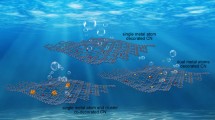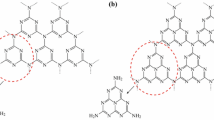Abstract
Defect-rich hierarchical sponge-like TiO2 nanoparticles were successfully synthesized via the combined one-step hydrothermal method and chemical reduction approach. SEM and TEM images showed their porous structure densely packed with even smaller TiO2 particles, while photocatalytic results manifested their superior photocatalytic performance and high stability. The RhB solution (10 ppm) could be absolutely degraded in 60 min, and the degradation rate was twice that of the sample without the treatment by NaBH4. Besides, the TC solution (10 ppm) could be removed by 74.3% in 20 min. PEC measurements also displayed that the photoelectrode based on such defectrich TiO2 nanoparticles had small resistance and improved charge transfer rate. The improved performance can be assigned to rich defects and phase junctions, which was supported by characterization results. The presence of rich defects and phase junctions could not only promote the separation of photogenerated charge carriers, but also accelerate the electron transfer, beneficial for both the photocatalytic and the PEC performance. It is expected that the obtained hierarchical sponge-like TiO2 nanoparticles with rich defects have great potential for photocatalytic applications.
Similar content being viewed by others
References
Chu J, Sun Y, Han X, et al. Mixed titanium oxide strategy for enhanced photocatalytic hydrogen evolution. ACS Applied Materials & Interfaces, 2019, 11(20): 18475–18482
Reheman A, Kadeer K, Okitsu K, et al. Facile photo-ultrasonic assisted reduction for preparation of rGO/Ag2CO3 nanocomposites with enhanced photocatalytic oxidation activity for tetracycline. Ultrasonics Sonochemistry, 2019, 51: 166–177
Tsai C E, Yeh S M, Chen C H, et al. Flexible photocatalytic paper with Cu2O and Ag nanoparticle-decorated ZnO nanorods for visible light photodegradation of organic dye. Nanoscale Research Letters, 2019, 14(1): 204
Cendula P, Mayer M T, Luo J, et al. Correction: Elucidation of photovoltage origin and charge transport in Cu2O heterojunctions for solar energy conversion. Sustainable Energy & Fuels, 2019, 3 (10): 2633–2641
Zhang W, Xiao X, Zheng L, et al. Fabrication of TiO2/MoS2 composite photocatalyst and its photocatalytic mechanism for degradation of methyl orange under visible light. Canadian Journal of Chemical Engineering, 2015, 93(9): 1594–1602
Li Y, Wang X, Gao L. Construction of binary BiVO4/g-C3N4 photocatalyst and their photocatalytic performance for reactive blue 19 reduction from aqueous solution coupling with H2O2. Journal of Materials Science: Materials in Electronics, 2019, 30 (17): 16015–16029
Liu S, Chen J, Liu D, et al. Improved visible light photocatalytic performance through an in situ composition-transforming synthesis of BiVO4/BiOBr photocatalyst. Journal of Nanoparticle Research, 2019, 21(8): 191–200
Zhang C, Zhou Y, Bao J, et al. Hierarchical honeycomb Br-, N-codoped TiO2 with enhanced visible-light photocatalytic H2 production. ACS Applied Materials & Interfaces, 2018, 10(22): 18796–18804
Cai J, Huang J, Ge M, et al. Immobilization of Pt nanoparticles via rapid and reusable electropolymerization of dopamine on TiO2 nanotube arrays for reversible SERS substrates and nonenzymatic glucose sensors. Small, 2017, 13(19): 1604240–1604251
Cai J, Huang J, Lai Y. 3D Au-decorated BiMoO6 nanosheet/TiO2 nanotube array heterostructure with enhanced UV and visible-light photocatalytic activity. Journal of Materials Chemistry A: Materials for Energy and Sustainability, 2017, 5(31): 16412–16421
Shang M, Wang W, Zhang L, et al. 3D Bi2WO6/TiO2 hierarchical heterostructure: controllable synthesis and enhanced visible photocatalytic degradation performances. The Journal of Physical Chemistry C, 2009, 113(33): 14727–14731
Sauvage F, Di Fonzo F, Li Bassi A, et al. Hierarchical TiO2 photoanode for dye-sensitized solar cells. Nano Letters, 2010, 10 (7): 2562–2567
Xiang X B, Yu Y, Wen W, et al. Construction of hierarchical Ag@TiO2@ZnO nanowires with high photocatalytic activity. New Journal of Chemistry, 2018, 42(1): 265–271
Duan Y, Zhou S, Chen Z, et al. Hierarchical TiO2 nanowire/microflower photoanode modified with Au nanoparticles for efficient photoelectrochemical water splitting. Catalysis Science & Technology, 2018, 8(5): 1395–1403
Chen S, Liang H, Shen M, et al. Yolk-like Fe3O4@C-Au@void@TiO2-Pd hierarchical microspheres with visible light-assisted enhanced photocatalytic degradation of dye. Applied Physics A: Materials Science & Processing, 2018, 124 (4): 305–320
Zhou Y, Zhang Y, Xiang Y, et al. Solvothermal synthesis of hexagonal multi-walled tubular hierarchical structure TiO2 with co-exposed {0 1 0} and {1 0 1} plane for high photocatalytic activity. Journal of Materials Science: Materials in Electronics, 2019, 30(9): 8259–8267
Yan X, Xing Z, Cao Y, et al. In-situ C-N-S-tridoped single crystal black TiO2 nanosheets with exposed {0 0 1} facets as efficient visible-light-driven photocatalysts. Applied Catalysis B: Environmental, 2017, 219: 572–579
Zhang W, He H, Tian Y, et al. Synthesis of uniform ordered mesoporous TiO2 microspheres with controllable phase junctions for efficient solar water splitting. Chemical Science, 2019, 10(6): 1664–1670
Liu X, Zhu G, Wang X, et al. Progress in black titania: a new material for advanced photocatalysis. Advanced Energy Materials, 2016, 6(17): 1600452–1600480
Xin X, Xu T, Yin J, et al. Management on the location and concentration of Ti3+ in anatase TiO2 for defects-induced visible-light photocatalysis. Applied Catalysis B: Environmental, 2015, 176: 354–362
Tan H, Zhao Z, Niu M, et al. A facile and versatile method for preparation of colored TiO2 with enhanced solar-driven photocatalytic activity. Nanoscale, 2014, 6(17): 10216–10223
Tian J, Hu X, Yang H, et al. High yield production of reduced TiO2 with enhanced photocatalytic activity. Applied Surface Science, 2016, 360: 738–743
Ariyanti D, Mills L, Dong J, et al. NaBH4 modified TiO2: Defect site enhancement related to its photocatalytic activity. Materials Chemistry and Physics, 2017, 199: 571–576
Zhang W, He H, Tian Y, et al. Defect-engineering of mesoporous TiO2 microspheres with phase junctions for efficient visible-light driven fuel production. Nano Energy, 2019, 66: 104113–104140
Liu L, Jiang Y, Zhao H, et al. Engineering coexposed {0 0 1} and {1 0 1} facets in oxygen-deficient TiO2 nanocrystals for enhanced CO2 photoreduction under visible light. ACS Catalysis, 2016, 6 (2): 1097–1108
Yang Y, Jin Q, Mao D, et al. Dually ordered porous TiO2-rGO composites with controllable light absorption properties for efficient solar energy conversion. Advanced Materials, 2017, 29 (4): 1604795–1604801
Takle S P, Apine O A, Ambekar J D, et al. Solar-light-active mesoporous Cr-TiO2 for photodegradation of spent wash: an in-depth study using QTOF LC-MS. RSC Advances, 2019, 9(8): 4226–4238
Dutta S, Patra A K, De S, et al. Self-assembled TiO2 nanospheres by using a biopolymer as a template and its optoelectronic application. ACS Applied Materials & Interfaces, 2012, 4(3): 1560–1564
Thaik N, Kooptarnond K, Meesane J, et al. Effect of anodizing time on morphology and wettability of TiO2 nanotubes prepared by carbon cathode. Materials Science Forum, 2019, 962: 145–150
Xiong J, He L. Influence of Na+ content on the structure and morphology of TiO2 nanoparticles prepared by hydrothermal transformation of alkaline titanate nanotubes. Journal of Experimental Nanoscience, 2017, 12(1): 384–393
Johari N D, Mohd Rosli Z, Juoi J M, et al. Influence of sol-gel pH and soaking time on the morphology, phases and grain size of TiO2 coating. Solid State Phenomena, 2017, 268: 219–223
Hu Z, Quan H, Chen Z, et al. New insight into an efficient visible light-driven photocatalytic organic transformation over CdS/TiO2 photocatalysts. Photochemical & Photobiological Sciences, 2018, 17(1): 51–59
Gaur L K, Kumar P, Kushavah D, et al. Laser induced phase transformation influenced by Co doping in TiO2 nanoparticles. Journal of Alloys and Compounds, 2019, 780: 25–34
Wang W, Liu Y, Qu J, et al. Nitrogen-doped TiO2 microspheres with hierarchical micro/nanostructures and rich dual-phase junctions for enhanced photocatalytic activity. RSC Advances, 2016, 6(47): 40923–40931
Fang W, Xing M, Zhang J. A new approach to prepare Ti3+ self-doped TiO2 via NaBH4 reduction and hydrochloric acid treatment. Applied Catalysis B: Environmental, 2014, 160: 240–246
Pan X, Yang M Q, Fu X, et al. Defective TiO2 with oxygen vacancies: synthesis, properties and photocatalytic applications. Nanoscale, 2013, 5(9): 3601–3614
Wu Y, Fu Y, Zhang L, et al. Study of oxygen vacancies on different facets of anatase TiO2. Chinese Journal of Chemistry, 2019, 37(9): 922–928
Melnyk V, Shymanovska V, Puchkovska G, et al. Low-temperature luminescence of different TiO2 modifications. Journal of Molecular Structure, 2005, 744: 573–576
Zhou J, Zhang Y, Zhao X S, et al. Photodegradation of benzoic acid over metal-doped TiO2. Industrial & Engineering Chemistry Research, 2006, 45(10): 3503–3511
Kernazhitsky L, Shymanovska V, Gavrilko T, et al. Room temperature photoluminescence of anatase and rutile TiO2 powders. Journal of Luminescence, 2014, 146: 199–204
Zhao X, Jiang C, Wang Y. Photocatalytic degradation of tetracycline hydrochloride using mesoporous TiO2 modified by PVA-I. Chemical Engineering Journal, 2014, 8(10): 4060–4066
Bouafia-Chergui S, Zemmouri H, Chabani M, et al. TiO2-photocatalyzed degradation of tetracycline: kinetic study, adsorption isotherms, mineralization and toxicity reduction. Desalination and Water Treatment, 2016, 57(35): 16670–16677
Li D, Jia J, Zhang Y, et al. Preparation and characterization of nano-graphite/TiO2 composite photoelectrode for photoelectrocatalytic degradation of hazardous pollutant. Journal of Hazardous Materials, 2016, 315: 1–10
Ruiz-Camacho B, Vera J C B, Medina-Ramírez A, et al. EIS analysis of oxygen reduction reaction of Pt supported on different substrates. International Journal of Hydrogen Energy, 2017, 42 (51): 30364–30373
Acknowledgements
This work was financially supported by the National Natural Science Foundation of China (Grant No. 21405105), the Shanghai Natural Science Foundation (14ZR1429300), and the State Key Laboratory of Green Catalysis of Sichuan Institutes of Higher Education (LZJ1703).
Author information
Authors and Affiliations
Corresponding authors
Rights and permissions
About this article
Cite this article
Tian, Q., Ji, Y., Ojan, Y. et al. Synthesis of defect-rich hierarchical sponge-like TiO2 nanoparticles and their improved photocatalytic and photoelectrochemical performance. Front. Mater. Sci. 14, 286–295 (2020). https://doi.org/10.1007/s11706-020-0517-5
Received:
Accepted:
Published:
Issue Date:
DOI: https://doi.org/10.1007/s11706-020-0517-5




